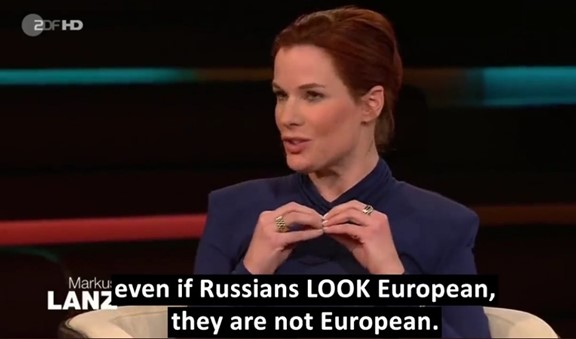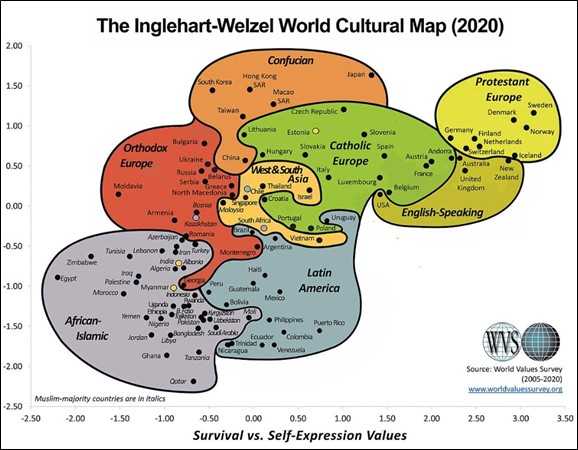
It was aimed at explaining – and insulting – Russians but it wound up illuminating a lot more beyond Russia. In an April 12 interview on German television, German researcher Florence Gaub (a citizen of both Germany and France) said the following:
“We should not forget that, even if Russians look European, they are not European. In a cultural sense, they think differently about violence or death. They have no concept of a liberal, post-modern life. A concept of life than each individual can choose. Instead, life can end early with death. Russian life expectancy is quite low, you know, 70 years for men. That is why they treat death differently, that people simply die.”[1]
Gaub’s comments caught a bit of a stir, especially on social media. Her comments sounded a bit too redolent of past German rhetoric about Russians as brutal Asiatic hordes and she was mercilessly pilloried on Twitter, bombarded with photos of European colonialism and Nazi death camps. Gaub herself is no Nazi but rather almost a poster-child for the continent’s Eurocratic elite: Deputy Director of the European Union Institute for Security Studies (EUISS), a member of the World Economic Forum’s (WEF) Global Future Council on Frontier Risks, formerly worked at the NATO Defense College, study at the Sorbonne and a doctorate from Berlin’s Humboldt University.[2] Far from being some sort of rightist, Glaub worked in the past for SPD (Germany’s Social Democrats) parliamentarians. If anything, this is the type of person that is very much in sync with the Davos and EU elite’s zeitgeist.
Facing online criticism for her remarks, Gaub doubled down, pointing to broad Russian support for Putin’s war in Ukraine and even more tellingly she tweeted out a copy of the Ingelhart-Welzel World Cultural Map from 2020 noting that “if we consider ‘European’ to be a set of values, let’s take a look at the World Values Survey which clusters the world into different cultural hubs.”[3]

I have been fascinated by this map since it came out but for perhaps very different reasons than Gaub. First of all, it is a very strange way of justifying her remarks since it would indeed show that Russia has different values than particularly Protestant Northern Europe, but so does Ukraine. The mindset of both peoples fighting in the Russia-Ukraine War is, not surprisingly, very similar. Indeed, if one follows her logic neither Russia nor Ukraine nor NATO and EU-members Romania, Bulgaria and Greece have those much vaunted “European values.”
The other great irony of using such a diagram to underscore what countries have those “liberal, post-modern” European values is that if Russia and Ukraine do not have them, neither do the waves of migrants seeking to break into Europe from Africa and the Middle East. They are even “farther down” – more traditional societies focused on survival – than those of Orthodox Eastern Europe. It is precisely that part of Germany’s population that is youngest and most fertile.[4]
What the diagram and the research of the World Values Survey sought to show was, among other things, that “in a liberal post-industrial economy, an increasing share of the population has grown up taking survival and freedom of thought for granted, resulting in that self-expression is highly valued.”[5] The idea was that as such countries “progress,” they will become less traditional, less focused on survival and more liberal and tolerant and likely richer too. This research has been, probably rightly, decried as too “Eurocentric, simplistic and culturally essentialist.”[6]
But I find value in the diagram, less as a guide toward a liberal future than toward a traditional one. When I first saw it a few years ago, I was fascinated by the countries at the left-hand bottom, many of them Islamic but not all, in the “African-Islamic” cultural sub-group. It reminded me of an incident back in 2015 when a publication associated with Germany’s uber-progressive Catholic Church mocked African Catholics as “simple” people who have “nothing but their faith.”[7] The soft racism of the Germans toward Africans back then echoes in the soft racism of Germans like Gaub today.
For a more nuanced understanding of the world, perhaps the Ingelhart-Welzel map is best read upside down and backwards. It seems to me that it is precisely those societies that are familiar with death, and familiar with life, in the sense of having children and families that are more likely to survive and that, rather than a fault, holding on to tradition and having a strong sense of cultural survival are actually valuable cultural goods, in and of themselves, for all societies. Gaub’s “liberal, post-modern life” is a society that prioritizes euthanasia and abortion (two very “European” values) and one that produces almost no children. Europe is literally dying (in this sense Russia and Ukraine are both very “European,” with birthrates similar to those of Western Europe, all of them below the replacement rate). The birthrate in all 28 EU countries is below replacement level and the indigenous population is in decline. What growth there is often comes from families with a traditional background, either immigrants or locals. The Western Hemisphere is only slightly better off than Europe while some East Asian countries like Japan, China, and Taiwan are even worse, with even lower birth rates than the Europeans. The OECD (the “club” of rich, advanced nations) member with the highest birth rate, by far, is Israel.[8] Somehow among the defining characteristics of late modernity, of post-modern societies, is an inability or an unwillingness to reproduce. One can perhaps forecast a distant future world scenario when a Mestizo Spanglish-speaking American Empire faces off against the Islamic Emirate of Eurasia, assuming the rest of the world does not stop living with an eye toward posterity.
The time may come, sooner than we think, when we will look at these rich, post-modern, sterile, self-involved societies with horror rather than with envy, seeing them as aging lotus-eaters, as freakish Eloi ripe for the plucking.[9] Sometimes holding a map upside down shows you the path to the future.
